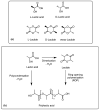Embracing Sustainability: The World of Bio-Based Polymers in a Mini Review
- PMID: 38611207
- PMCID: PMC11013738
- DOI: 10.3390/polym16070950
Embracing Sustainability: The World of Bio-Based Polymers in a Mini Review
Abstract
The proliferation of polymer science and technology in recent decades has been remarkable, with synthetic polymers derived predominantly from petroleum-based sources dominating the market. However, concerns about their environmental impacts and the finite nature of fossil resources have sparked interest in sustainable alternatives. Bio-based polymers, derived from renewable sources such as plants and microbes, offer promise in addressing these challenges. This review provides an overview of bio-based polymers, discussing their production methods, properties, and potential applications. Specifically, it explores prominent examples including polylactic acid (PLA), polyhydroxyalkanoates (PHAs), and polyhydroxy polyamides (PHPAs). Despite their current limited market share, the growing awareness of environmental issues and advancements in technology are driving increased demand for bio-based polymers, positioning them as essential components in the transition towards a more sustainable future.
Keywords: bio-based polymers; polymeric materials; polymers; renewable sources; sustainable materials.
Conflict of interest statement
The authors declare no conflicts of interest.
Figures











References
-
- Galbis J.A., García-Martín M.G. In: Monomers, Polymers and Composites from Renewable Resources. Belgacem M.N., Gandini A., editors. Elsevier; Amsterdam, The Netherlands: 2008.
-
- Nakajima H., Dijkstra P., Loos K. The Recent Developments in Biobased Polymers toward General and Engineering Applications: Polymers That Are Upgraded from Biodegradable Polymers, Analogous to Petroleum-Derived Polymers, and Newly Developed. Polymers. 2017;9:523. doi: 10.3390/polym9100523. - DOI - PMC - PubMed
-
- Isikgor F.H., Becer C.R. Lignocellulosic Biomass: A Sustainable Platform for the Production of Bio-Based Chemicals and Polymers. Polym. Chem. 2015;6:4497–4559. doi: 10.1039/C5PY00263J. - DOI
Publication types
LinkOut - more resources
Full Text Sources
Molecular Biology Databases

